Site blog
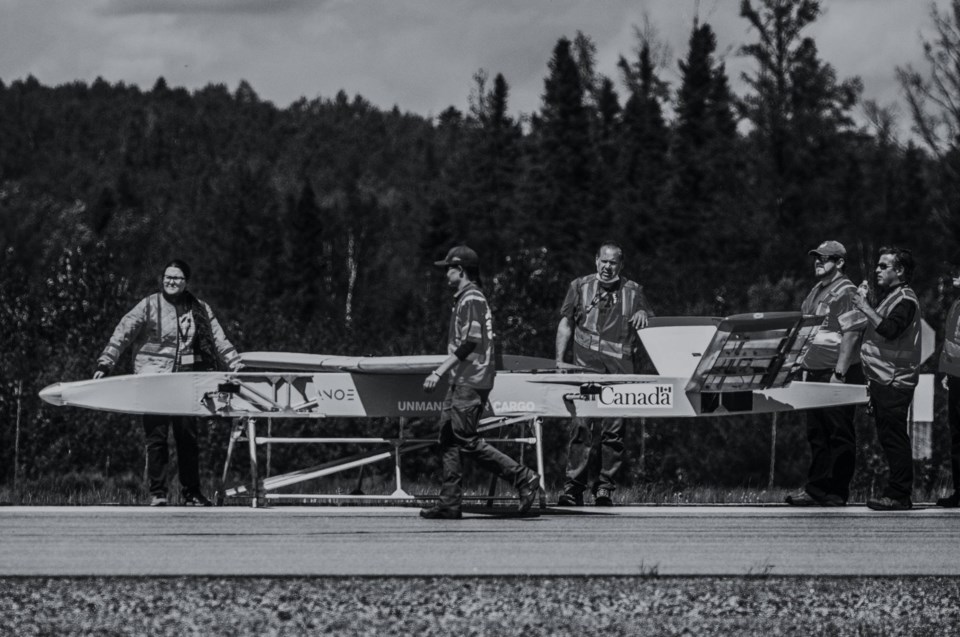
Sky Canoe has been producing remotely piloted, zero-emissions light cargo aircraft out of its headquarters in Mississaugas of Scugog Island First Nation since its inception in 2018. Sky Canoe website
An Indigenous company that’s in the business of producing remotely piloted, zero-emission light cargo aircraft to ship goods to rural and remote communities is pitching a partnership with a First Nation on Lake Huron’s north shore that would see the small community become a northern logistics hub for its operations.
Sky Canoe — an Indigenous-owned company led by Mississaugas of Scugog Island First Nation in southern Ontario — held a pair of community information sessions in Mississauga First Nation last week to inform band members of the proposal that’s currently on the table.
The company’s president and chairman, Jason Dudek, says a letter of intent has already been signed between both parties, and a pilot project could be rolled out in the First Nation some time in 2023.
“The idea right now is to do a pilot project, demonstrate ourselves to the community — and as long as the community is continuing behind us, we’ll proceed,” said Dudek. “But obviously we’re there to serve the community and be guided by them, and that’s the defining characteristic of our engagement.”
Sky Canoe has so far produced 11 of its remotely piloted aircraft, which has attracted interest from oil companies and other businesses since the company's inception in 2018.
While five of its builds were strictly prototypes, the remaining six have all been sold within the past two years.
Now, the company wants to expand its footprint by making Mississauga First Nation — a community approximately 140 kilometres east of Sault Ste. Marie with 378 people living on reserve — its base of operations in the North.
“Honestly, we could be continuing to focus on just selling as much as possible, but our commitment to Mississauga First Nation is really primary right now,” said Dudek. “It’s our main focus as a company that we make this pilot project happen and make sure Sky Canoe is doing what it’s supposed to be doing, which is improving the lives, food security and economic development of remote communities by reducing cargo costs,” he said.
Dudek says Sky Canoe’s electric, long-range aircraft is built from the ground up in Mississaugas of Scugog Island First Nation with a goal to deliver goods to rural and remote communities safely and efficiently at 75 per cent less cost.
“When you take the pilot and the fuel out of the equation, obviously, as you can imagine, it drives down the costs,” he said. “But the silver lining on that, too, is that we’re zero emissions, so it’s a great product for the future of Canada’s economy where we really need to transition to the low-carbon economy.”
Four full-time jobs could be made available to members of Mississauga First Nation as part of the proposed pilot project.
“We’re not offering a huge quantity of jobs, but the jobs we’re creating are really exciting, well-paying, high-quality jobs,” said Dudek. “We’re actually in the business of attracting some of the youth that have migrated down to Toronto looking for opportunities in the cutting-edge sector type of stuff to come back to the community.”
Dudek credits Mississauga First Nation for having an “outstanding team” to work with while Sky Canoe works to get the pilot project for its northern logistics hub off the ground.
“The team there is really visionary," he said. "They have a really, really good grasp on where they want to go as a community, and that actually really helps businesses like us engage with them."
Mississauga First Nation Chief Bob Chiblow could not be reached for comment.
— Soo Today

Over 80,000 drone IDs were exposed in a data leak after a database containing information from dozens of airspace monitoring devices manufactured by the Chinese-owned DJI was left accessible to the public.
Think twice before taking out your shiny new drone for a spin near the Cannes Film Festival, a prison, a nuclear power plant, or an airport. Enhanced security institutions use devices to monitor drone movement, posing a privacy risk to its owner.
Recently, the Cybernews research team stumbled upon an unprotected database with over 90 million drone-monitoring logs generated by DJI devices – the largest market player in the world that sells both drones and devices to surveil them.
The surveillance race
Used by the military, businesses, and consumers, drones are “fundamentally changing aviation.” Therefore, the US Federal Aviation Administration (FAA) envisions integrating drones into the National Airspace System (NAS) by identifying all unmanned aircraft systems (UAS.)
The FAA introduced remote ID – analogous to license plates for drones – to identify owners of all drones in case they are flying in an unsafe manner or where they are not allowed to fly. Remote ID will provide information about drones in flight – the identity, location, and altitude of the drone and its control station or take-off location.
But it seems that Chinese-owned DJI, already controlling the lion’s share of the drone market worldwide, got there first. In 2017, it introduced the AeroScope device to provide an in-flight drone identification system.
In fact, the company boasted about protecting the prestigious Cannes Film Festival 2022 from unsolicited intrusions from aerial cameras – AeroScope was used by police officers to watch for drones in the area’s no-fly zone.
“From temporary events like festivals, government events, and major sporting events to fixed sites like airports, prisons, and nuclear power plants, AeroScope is a simple, robust technical solution to provide immediate information about DJI drones in the area – from their flight paths to their pilot locations to their serial numbers,” DJI said.
The Shenzhen-headquartered company holds a whopping 70% of the global consumer and enterprise drone market, according to the Business Insider report from 2020.
DJI was blacklisted by the Biden Administration in 2021 for its alleged involvement in the surveillance of the Uyghur Muslim minority in China.
On October 5, 2022, the US Defense Department added DJI and a dozen other companies to a list of Chinese entities believed to be connected to the Chinese military. Pentagon paved the way to further restrictions on their businesses, arguing that access to advanced technologies is crucial for modernizing the People’s Liberation Army.
DJI was also in the spotlight after Ukraine’s Vice Prime Minister Mykhailo Fedorov accused the company of helping the Kremlin to kill civilians by allowing Russia to freely use DJI devices, including AeroScope, on Ukrainian soil.
The discovery
AeroScope, a drone-monitoring device by DJI, can “identify the vast majority of popular drones on the market today.”
The Cybernews Research Team discovered an open database with over 90 million entries of drone-monitoring logs created by 66 different DJI AeroScope devices, with the majority of them (53) being located in the US. Some were located in Qatar (six) and a few in Germany, France, and Turkey.
Logs included the drone's position, model and serial number, the position of the drone’s pilot, and home location (usually the point of take-off). No personally identifiable information (PII) was present in the dataset. In total, we found over 80,000 unique drone IDs in the instance.
DJI told Cybernews that a 54.5GB-strong dataset, discovered by our researchers on July 11 and hosted by AWS in the US, is not their property, meaning that the data was most likely exposed by their client using AeroScope devices to monitor the airspace for drones.
Since the server was hosted on AWS and didn’t have any domains assigned to it, it was impossible for our researchers to track down the owner even with the help of VirusTotal, Centralops Domain dossier, nmap, and dig, among other useful open-source-intelligence (OSINT) tools.
Cybernews informed both DJI and AWS about the leaky database for them to fix the issue as soon as possible to reduce the risk of threat actors accessing the dataset. AWS said it had passed our “security concern on to the specific customer for their awareness and potential mitigation.”
Troubling data
Needless to say, the surveillance of drones is upsetting enough for people who simply take theirs out for a spin or to capture aerial footage. Given the security concerns, tracking of drones is inevitable: however, it’s reasonable to expect that surveillance data is kept in protected databases.
Aras Nazarovas, a Cybernews researcher, said this information is upsetting to hobbyists since it can essentially show the routes they take with your drone.
“For people who launch drones in their backyards, there is an added danger of revealing their address, and the fact that they are rich enough to have a DJI drone – prices range from $300 to $13,700, and you can see which drone they have,” Nazarovas said.
By Jurgita LapienytėRadio-telemetry for animal tracking experts Wildlife Drones, has partnered with innovative UAV (unmanned aerial vehicle) developer Freefly Systems. The partnership delivers a powerful radio-telemetry solution with Freefly Systems US made drones. The Astro by Freefly is a multirotor VTOL drone, which crucially for wildlife tracking, it is quiet.
With low noise in the VHF band, the Freefly System’s Astro allows Wildlife Drone’s radio-receiver to detect even the faintest VHF radio-tag signals from a distance. With over 100,000 successful commercial drone flights, plus multi-band RTK, LTE cloud connectivity and mission computer, the Astro makes surveying extended areas to collect radio-telemetry data easy.
Wildlife Drone’s innovative use of drone tracking technology for improved animal tracking research enables field operators to collect data faster, over greater distances. Wildlife Drones work with people across Australia, the United States and abroad, to track the movements of some of the world’s most endangered species.
Compatible with any unique frequency VHF tags globally, Wildlife Drone’s unique sensor technology and real-time analysis software helps scientists and land managers to survey vast and inaccessible terrain to track and monitor wildlife, invasive species and livestock.
Simple integration and real-time data analytics
Radio-track up to 40 tagged animals simultaneously
View animal locations in real-time
Save time, effort and field staff costs
Flexible tracking whenever needed
Maximize tag detection and survey coverage
Effectively meet animal ethics requirements
By Sarah Simpson
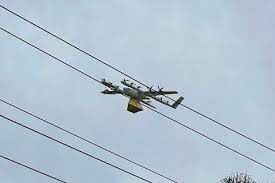
The incident caused a power outage for 2,000 customers.(Supplied: Energex)
Thousands of people were left without power after a food delivery drone crashed into powerlines yesterday in what has been described as a "first" by Energex.
Key points:
Power was restored for most customers in 45 minutes, with 300 without power for three hours
Wing, the food delivery company, says the drone crashed into powerlines as it made a precautionary landing
Energex spokesman Danny Donald says drones hitting powerlines can be very dangerous
Energex spokesman Danny Donald told ABC Radio Brisbane people in Browns Plains, south of Brisbane, and the immediate surrounds lost power yesterday after a drone carrying food hit the network about 2pm.
Energex restored power for about 2,000 customers within 45 minutes, while 300 customers in the immediate vicinity of that drone were without power for three hours.
"The meal was still hot inside the drone's delivery box when the crew got there," Mr Donald said.
"We've never seen these delivery drones hit the network. It's rare.
"This is the first time that I've seen it happen. It could have simply been an equipment malfunction. It may have been human error."
Mr Donald said there was no permanent damage to the network and thus would not be requesting the food delivery company to cover the damage.
However, he said, if any person or company caused network damage, for example, by reversing into a power pole, Energex could seek the cost of damage repairs.
He said everyone, including companies, had to be careful not to let objects hit power lines or cause damage to the network.
"While this is a different circumstance, it's no different to the previous generation flying kites," Mr Donald said.
"Fifteen years ago, we asked people to be careful if they were giving their children kites for Christmas and where they were flying them. Now we're asking parents to be very careful with where their kids fly their drones," he said.
"It could bring down live powerlines. The last thing we want is people in danger."
Energex asks for common sense to prevail
Over the years, a number of objects, including shoes, umbrellas, trampolines, kites and even toilet seats, have caused issues, he said.
Mr Donald said while there was an immediate danger if anything hit live powerlines, there was also a significant inconvenience to residents and businesses that lost power.
"It's not just homes and businesses. We're talking street lights and traffic lights and that sort of thing," he said.
"It's common sense really, and we're asking for that common sense to prevail."
A spokesperson for Wing, the company that operates the drone delivery, said a drone made a "precautionary controlled landing yesterday … and came to rest on an overhead power line".
"We immediately reported this to Energex, who attended the location, the spokesperson said.
"Two hours later, during the retrieval process, there was a power outage in the area.
"We're sorry for any inconvenience caused. We're currently conducting a review of yesterday's event."
ABC Radio Brisbane /
Antonia O'Flaherty, Michelle Collins and Abbey Wiltshire
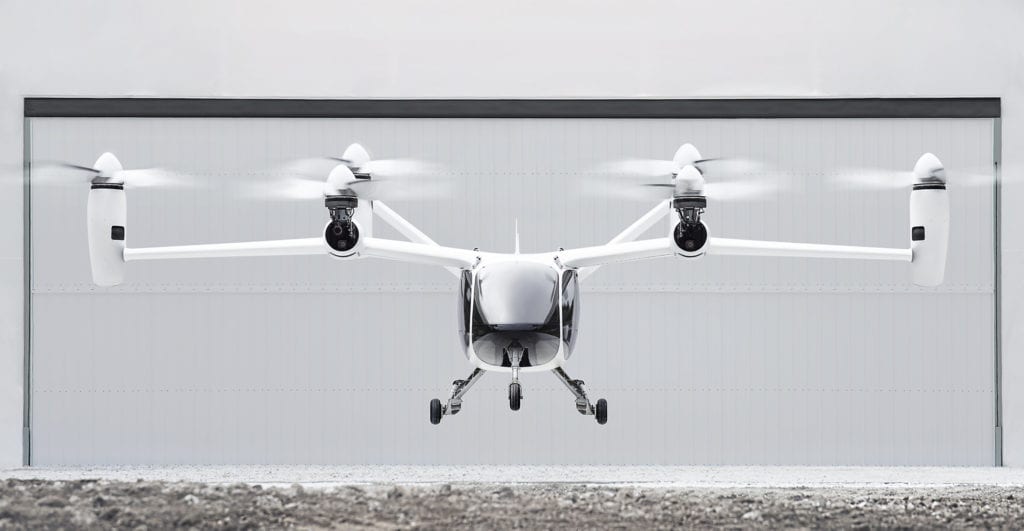
In December 2020, Joby Aviation acquired Uber Elevate to create integration between ground and air travel for future customers
The global eVTOL aircraft market is expected to grow from $6.73 billion in 2021 to $18.92 billion in 2026 at a compound annual growth rate (CAGR) of 23.66%, according to Research and Markets.
The eVTOL aircraft market consists of sales of eVTOL aircraft that use motors, batteries, fuel cells, and electronic controllers to generate electric power to hover, take off, and land vertically.
The main technologies used in eVTOL aircraft include vectored thrust, multirotor, and lift plus cruise. Vectored thrust changes the thrust angle from the engine or motor to control the attitude or angular velocity of the aircraft typically used to control pitch and yaw attitude on boosters and upper stages.
Propulsion systems include fully electric, hybrid electric, and hydrogen-electric in applications including air taxis, air shuttles and air metro, private transport, cargo transport, air ambulance and medical emergency, last-mile delivery, inspection and monitoring, surveying and mapping, surveillance, special mission, among others.
North America was the largest region in the eVTOL aircraft market in 2021 and is expected to be the fastest-growing region in the forecast period. The regions covered are Asia-Pacific, Western Europe, Eastern Europe, North America, South America, Middle East and Africa.
For instance, in March 2020 Dassault Systèmes estimated the growing need for eVTOL aircraft where the market will grow exponentially, to an estimated 1.3 billion passengers over 20 years, with a demand for 28,000 eVTOL aircraft.
Major companies operating in the eVTOL aircraft market are implementing technologies such as IoT, ultra edge hydrogen and battery cell, onboard sensors and collision prevention systems, AI technology and 5G communication.
In April 2022, Hyundai explored hydrogen fuel cell technology for eVTOL aircraft and expects hydrogen fuel cell technology to have a long enough range to complete intercity trips.
In December 2020, Joby Aviation acquired Uber Elevate to create integration between ground and air travel for future customers, by integrating their respective services into each other’s apps.
The countries covered in the eVTOL aircraft market report are Australia, Brazil, China, France, Germany, India, Indonesia, Japan, Russia, South Korea, UK and USA.
This article was compiled by the eVTOL Insights editorial team.

The government needs to give companies access to designated military installations to conduct quarterly scientific R&D testing without potential customers present. As it stands today, this is a national security risk because foreign drone mitigation companies can innovate faster as a result of their governments’ streamlined R&D testing processes.
Should the public be concerned about the threat of unauthorized drone use at large outdoor events, like sports venues, and other large infrastructure locations? Unfortunately, the short answer is ‘yes’.
Drone use has exploded in recent years. The number of drones being flown in the U.S. now exceeds 2.5 million. Although most instances of unauthorized drone incursions at or near large outdoor events are from non-malicious operators, there have been instances where bad actor drone operators purposely caused harm or interfered with the event. Regardless of intent, the flying of unauthorized drones overhead presents a significant security risk for event goers in terms of their safety. Drone operators do make mistakes and drones do malfunction. Both can cause severe injuries if they were to hit a spectator. Taking it one step further, if drones were used for nefarious reasons, they could easily drop harmful substances such as explosive devices on event goers.
In 2018, the Preventing Emerging Threats Act was passed by Congress to provide the Department of Homeland Security (DHS) and the Department of Justice (DOJ) with the necessary tools to effectively counter drones or Unmanned Aircraft Systems (UAS). That bill is set to expire next month. Last month, the Safeguarding the Homeland from the Threats Posed by Unmanned Aircraft Systems Act was advanced by the Senate Homeland Security and Governmental Affairs Committee and awaits the full Senate for consideration. This bill, which was introduced by U.S. Senators Peters, Hassan, Johnson, and Sinema, would renew the legislation passed in 2018 and further expand its authorities by allowing state and local law enforcement to protect communities from drone threats.
But does this legislation go far enough? How much would this help in addressing the threat landscape, specifically when it comes to scenarios where federal officials aren’t protecting a site or event? The bill definitely enhances the capabilities of federal, state, and local governments to protect critical infrastructure by detecting and in some cases interdicting drones that pose a threat.
The bill provides an opportunity for the Federal Government to carry out a pilot program to evaluate the potential benefits of State, local, Tribal, and territorial law enforcement agencies taking actions that are necessary to mitigate a credible threat. If the pilot program is successful, it could expand the federal government’s coverage or ‘security umbrella’ against unauthorized drone use. In addition to the benefit of having different levels of government working together, expanding the ‘security umbrella’ will also provide more of a deterrence factor for bad actors as well as non-malicious drone operators.
What more needs to be done to adequately protect sites like outdoor sporting venues from drones? Before you can mitigate drone threats at stadiums and other critical infrastructure locations, you need to have the ability to accurately detect a drone as well as have the ability to accurately assess the risk. You have to determine, through threat assessment techniques, if the identified drone is being operated by someone without malicious intent, such as a reckless neighborhood kid, or a bad actor. We can’t afford to have false positives or any questions before taking steps to mitigate the threat. Once these factors are determined, the appropriate tiered mitigation response can be deployed based on the overall facility’s risk profile. For example, defending an outdoor arena from drones most likely could use a Tier 1 mitigation response such as enabling the authorities to take over the controls of the unauthorized drone through a Radio Frequency (RF) Takeover. This is the safest form of mitigation. From there, if needed, authorities could escalate to a Tier 2 response, such as the use of RF jamming or a Tier 3 response, which might involve the use of projectiles, such as another drone, to take down the unauthorized drone.
Are there any concerns about using UAS mitigation technology around sites like outdoor sporting venues? If passed, the legislation would significantly improve the homeland’s ability to defend against the unauthorized use of drones at or near stadiums and critical infrastructure. The bill however doesn’t go far enough when it comes to supporting drone mitigation companies in their efforts to conduct research and development (R&D) testing of their equipment domestically. There is currently no avenue for companies to test most forms of mitigation without paying tens or hundreds of thousands of dollars per day to military bases or showing up at official demonstration events. The government needs to give companies access to designated military installations to conduct quarterly scientific R&D testing without potential customers present. As it stands today, this is a national security risk because foreign drone mitigation companies can innovate faster as a result of their governments’ streamlined R&D testing processes. Unfortunately, U.S. companies,have to ship their equipment abroad, perform the testing, and then ship the equipment back in a condition ready for demonstrations before government officials.
Another pressing concern is that only one law enforcement agency can be trained each month over a five-year period, limiting the total number of agencies with counter-drone training to 60. Considering the number of stadiums and critical infrastructure locations there are around the country, that number doesn’t even scratch the true need.
In summary, the renewal and expansion of authorities of the Safeguarding the Homeland from the Threats Posed by Unmanned Aircraft Systems Act provides our national security agencies with some of the tools required to mitigate the serious threats posed by UAS. But more is needed and more is needed now. To ensure that drones don’t disrupt or harm our way of life, we must provide federal, state, and local authorities with the complete set of tools to mitigate drone threats while maintaining the civil rights and liberties of responsible unmanned aircraft operators.
By
Steve Karoly
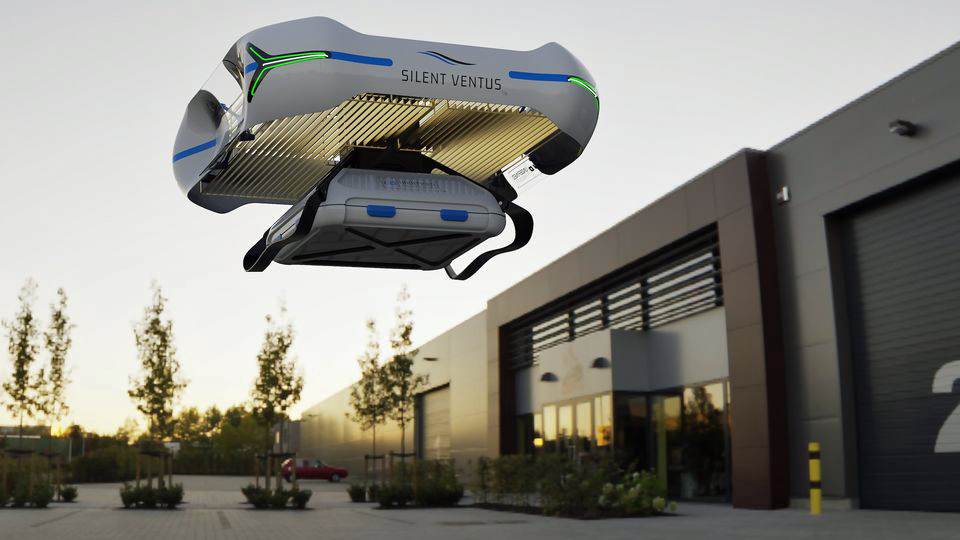
Florida's "silent" flying dish-rack, powered by ionic propulsion, is on track for commercial rollout in 2024, according to Undefined Technologies, which has released new outdoor flight test video. We remain curious, but unconvinced it'll be viable.
The "Silent Ventus" drone doesn't use propellers to fly. Instead, its entire broad structure creates two stacked grids of electrodes, designed to create high-voltage electric fields that can ionize the oxygen and nitrogen molecules in the air, freeing electrons to give them a positive charge, and then propelling these downward to create an "ionic wind" that can produce thrust.
It's not new; ionic propulsion has been used in space, and as we pointed out when we first saw the Silent Ventus drone project, for a few very small-scale terrestrial projects as well, one of which was used to levitate Orville the mouse in 2003. Undefined says its "Air Tantrum" technology yields "higher levels of thrust, up to 150% compared to current ion thruster technologies."
The company first showed off its tech in 2020, claiming a 25-second flight, but showing only a few wobbly seconds in a "test lab" video that looked suspiciously like it was filmed in a small box, despite the loud protestations of prominent height markers up each wall. The company subsequently said that this test drone made about 90 dB of noise – a lot closer to "hairdryer" than "silent."
Earlier this year, it claimed a two-and-a-half-minute indoor flight, at a reduced noise level of 85 decibels, and released a 39-second video as proof.
Now, the company says it's flown a prototype for a solid four and a half minutes, documented in true Undefined fashion with one minute, 17 seconds of edited video, as embedded below. It says it achieved a noise level below 75 dB, whatever the video might sound like, and it's calling for further investment toward a cargo delivery drone product it says will fly for 15 minutes and make less than 70 dB by the end of 2023.

"This 4+ min flight required advances in the chemical composition of the batteries that can now provide us with higher energy densities," says Undefined's Lead Aerospace Engineer Thomas Benda Jr. in a press release. "This improvement is part of our efforts to target lighter weights.”
It's unclear whether hitting 15 minutes of endurance (as per the roadmap) will require further advances in battery chemistry, or whether this company has other tricks up its sleeve. And it's unclear what kind of endurance can be expected from a delivery version of the aircraft carrying a useful payload. It's also undefined exactly how far from the drone Undefined is taking its noise readings; even the Joby S4 eVTOL air taxi stays under 65 dB when the measurement's taken 100 m (330 ft) from the vertipad.
Undefined says its "silent" 70-dB drones will cause far fewer noise complaints in urban cargo delivery services than propeller-forced designs – although established drone delivery company Wing has already fielded complaints about its drones, which were recorded at 69 dB at a 15-m (50-ft) distance back in 2019.
We have other reservations. We don't know how Undefined can control yaw with its design, absent the typical torque reactions from rotating propellers – although it sure seems capable of spinning in the company's render video. The necessarily large airframes required would appear to present quite a sail for a decent breeze to catch, which might make these things a liability in anything but ideal weather.
They're clearly a fair bit larger than prop-based multicopters, even without a payload, and they're also more fragile, making them harder to transport and store. Every time we've seen one fly, it's looked wobbly, and every time we've seen one land, it's come down hard enough to shake the propulsion racks about like Jell-O.
I'm not gonna lie, I'm also put off by lily-gilding press release headlines like, "Ion propulsion drone proves its commercial viability," and presentations that spend seven minutes hyping up the problem, but only two giving a vague outline of the solution, along with precious little technical detail. Each insignificant on its own, all these little things add up to a certain whiff that makes me uncomfortable.
Still, it's undeniably cool to see these things flying on electric wind alone, and for all the uncertainties and issues we've got, it sure does seem that these guys have built an ion-drive drone prototype capable of flying outdoors and well above the tree-line. We'd want to see the thing in person and do plenty of due diligence before throwing any investment money down, but whether or not this thing makes it to wide-scale commercial use, it's definitely a neat curiosity.
By Loz Blain

Silicon Valley-based air taxi developer Kittyhawk has decided to close its doors after more than 10 years.
Kittyhawk, the air-taxi company backed by billionaire Google co-founder Larry Page, will be closing down, dealing a setback to the long-elusive dream of developing flying cars.
“We have made the decision to wind down Kittyhawk,” the company said on Twitter. “We’re still working on the details of what’s next.”
The company’s technology is expected to live on in the form of its Wisk Aero joint venture with Boeing Co. Wisk’s operations won’t be affected by Kittyhawk’s shutdown, Boeing said on Wednesday.
Kittyhawk traces its history to 2010, when a company then known as Zee.Aero set out to pioneer the market for so-called eVTOLs -- electric vertical takeoff and landing aircraft -- ultimately with the goal of democratizing the skies. The secretive company was run by Sebastian Thrun, a Google veteran who worked on self-driving cars, augmented-reality glasses and other projects.
The business was one of several startups working on the concept, which has proven to be a greater challenge than some expected. Air taxis have suffered crashes during testing in recent months, raising concerns about their safety.
Insider previously reported on Kittyhawk’s plans to close.
Kittyhawk formed its Wisk venture with Boeing Co. in 2019, and the airplane manufacturer went on to invest $450 million in the partnership. Earlier this week, Boeing and Wisk presented their vision for a world where eVTOLs can coexist with larger commercial aircraft.
“Kittyhawk’s decision to cease operations does not change Boeing’s commitment to Wisk,” a spokeswoman for the plane manufacturer said in an email. “We are proud to be a founding member of Wisk Aero and are excited to see the work they are doing to drive innovation and sustainability through the future of electric air travel.”
The aviation titan helped showcase Wisk’s rotor-powered Cora aircraft at the Farnborough International Airshow in July. Along with financing the business, Boeing has been providing engineering resources for a larger, electric four-seater aircraft that Wisk intends to eventually certify with US regulators.
The air-taxi market still has numerous competitors, including Joby Aviation Inc., Archer Aviation Inc., Germany’s Lilium NV and Brazil’s Eve, but they face uncertain prospects for these futuristic vehicles. Aviation regulators haven’t yet certified the new generation of flying machines to transport humans.
Kittyhawk’s goal was to make an air taxi that could be remotely piloted, was smaller and lighter than other eVTOLs, and could take off from nearly anywhere. The company was targeting a cost of less than $1 a mile, which would have made the taxis cheaper than ride-sharing services.
Now Kittyhawk’s shutdown closes a chapter for one of the highest-profile eVTOL pioneers -- and shows how hard the market is to crack. As of Wednesday, the company still had this message on its home page: “If anyone can do this, we can.”
ByMark Bergen and Julie Johnsson
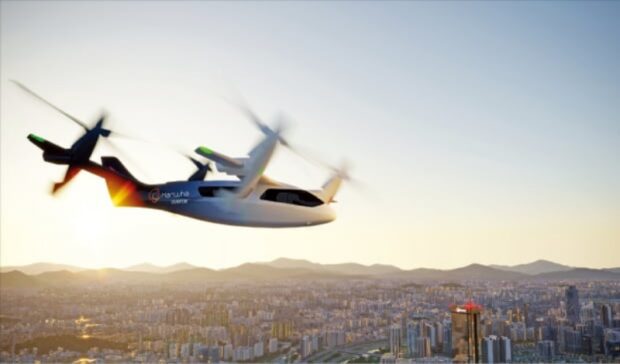
South Korea’s resort island of Jeju will launch air routes for Urban Air Mobility (UAM) and drone taxis dedicated to tourists in the island by 2025, as the first municipality in the country to do so.
Aimed at offering quick and accessible air mobility in the near future, the routes will connect the island’s popular tourist spots through the coast with quick and accessible air mobility in the near future.
Jeju Island, together with South Korean aviation company Kencoa Aerospace and the Jeju Free International City Development Center (JDC), has devised three types of UAM routes on the island.
The first route connects Jeju International Airport to the island’s southern Mosupo area, which then links Moseulpo to further down to Gapado and Marado. The third route moves along the east coast near Seongsan Ilchulbong, a popular site also known as Sunrise Peak.
“This would allow tourists to hop on the electric vertical take-off and landing (eVTOL) aircraft at Jeju airport to directly land at tour spots and transfer to drone taxis nearby. The time frame would be around 2025,” said Kencoa Aerospace Executive Chung Chan-young.
Jeju Special Self-Governing Province also plans to set up a Vertiport –- a helipad-like area that can be on land, water or a structure on which eVTOLs can take off and land — at large-scale hotels where many visitors stay.
Jeju’s idea of deploying UAM as tourist transportation is highly feasible and can happen early, Chung said, citing Seoul City’s plan to “test” a UAM route that connects Gimpo International Airport to central Yongsan-gu, Seoul. The plan, however, has hit a snag as the presidential office was relocated to Yongsan-gu in May.
“Flying a UAM aircraft through the coast in the island faces less troubles compared to running an air taxi in Seoul, where flying drones or aircrafts in areas like Yongsan is heavily restricted by government regulations,” said Chung.
According to the Transport Ministry, major districts in Seoul and the entire airspace along the Han River are no-fly zones.
“Jeju works as a perfect test bed and the best location to leverage UAM for the area’s advantages. Examining geographical features through the coastline is less complicated, and establishing a Vertiport on the sea can also work,” Chung added.
A consortium led by Hanwha Systems is also readying unmanned aerial vehicle for sky tour around the Jeju resort island in South Korea starting 2025.
Dubbed K-UAM Dream Team Consortium, consisting of Hanwha Systems, SK telecom, and the Korea Airports Corp., signed a memorandum of understanding with the Jeju Special Self-Governing Province on the pilot air mobility program.
Hanwha will be in charge of developing urban air mobility vehicles and navigation solutions and providing maintenance, repair, and operation (MRO) services. The Korea Airports Corp. will build “vertiports,” or UAM aircraft take-off and landing sites, and develop a traffic control system to transport travelers between the Jeju International Airport and major tourist destinations on the island.
SK telecom will provide UAM services and develop mobility platforms, while the Jeju Province will provide the necessary sites and infrastructures for the pilot program.
“We will push ahead with our pilot program to make a shift in urban mobility,” said Eoh Sung-chul, CEO of Hanwha Systems.
Meanwhile, the Transport Ministry has submitted its draft of a bill that would set up requirements and regulations for UAM, The Korea Herald learned through interviews. It is the first of its kind in the world, according to sources. If approved by the National Assembly, South Korea would become the first country to have regulations dedicated to UAM, the sources added.
The special law is expected to separate UAM from the legal boundary of the current aviation law. Flying cars would be advised not to fly within the altitude of helicopters, which is at around 450 meters above ground. The rule for UAM could range between 300 to 600 meters above land.
Under the government’s plan to commercialize UAM in central cities by 2025, the Transport Ministry kicked off a K-UAM Grand Challenge in February to coordinate all of South Korea’s UAM-related activities as part of its focus to enable emerging aviation markets.
Major firms like SK Telecom, Hyundai Motor Group and Hanwha Systems have formed consortiums to participate in the government-led evaluation and demonstration test, which will take place in Goheung, South Jeolla Province from next year.
Sources: The Korea Herald; Pulse

The SABER exoskeleton suit is tested at Kentucky's Fort Knox in May. (Larry McCormack)
Futuristic military dreams of an Iron Man exoskeleton suit might be giving way for something simpler: a lightweight wearable to help with back pain.
The new suit, which weighs just three pounds, is a soft harness that soldiers strap around their shoulders and legs. Soldiers can press a button on the suit by their left shoulder, which activates the straps running along their back to help ease the burden when lifting heavy objects like artillery rounds, boxes or guns.
Its name is a mouthful, dubbed the Soldier Assistive Bionic Exosuit for Resupply, or SABER. It is developed by the U.S. Army and Vanderbilt University, and slated to be deployed in the field in 2023.
SABER is a departure from the clunky, robotic “warrior suits” the military has designed in the past, and is instead a lightweight, flexible accessory soldiers can wear while moving heavy machinery or artillery around. Creators say this approach is better, because it solves a specific problem soldiers have while not getting in the way.
“[The Army] initially tried to create Iron Man,” Karl Zelik, a lead designer for SABER and associate professor of mechanical engineering at Vanderbilt University, said. “They had these full-body robotic systems that hoped to do everything but ultimately effectively did nothing because they [were] too bulky and heavy and complex and costly … This exosuit is about as far away from Iron Man as you can get.”
Back pain is widespread in the Army and has a significant impact on operations. Lower back injuries result in more than 1 million lost, or limited, service days for soldiers each year, according to the U.S. Army Public Health Center. Roughly 460 soldiers are diagnosed with back overuse injuries every day, U.S. Army data shows.
To solve that, the military turned to its Pathfinder project — which aims to innovate Army operations by having soldiers collaborate with universities — and invested $1.2 million into creating the SABER prototype suit.
To date, roughly 100 soldiers have tested the suit at three different Army bases. In May, 11 soldiers with the Army’s 101st Airborne Division used the SABER exoskeleton suit while on a training mission at Fort Knox, which required them to lift heavy boxes of ammo and move a howitzer gun multiple times a day, Zelik said.
“Lifting 60-pound rounds you get worn out,” Dale Paulson, a private first class with the 101st Airborne Division who tested the suit, said in a statement. “Wearing the suit really helped a lot, especially with getting the rounds out of the back of the truck.”
Now, the design of the suit moves from Vanderbilt University and the Pathfinder project to a spinoff corporation called HeroWear that will manufacture the device, Zelik said.
The challenge ahead, Zelik added, is getting the product approved through the Army’s “very complicated” acquisition process. If that happens, the effects could be significant.
“You have a lot of people who are getting hurt,” he said. “We have the opportunity to help prevent some of those injuries.”
By Pranshu Verma